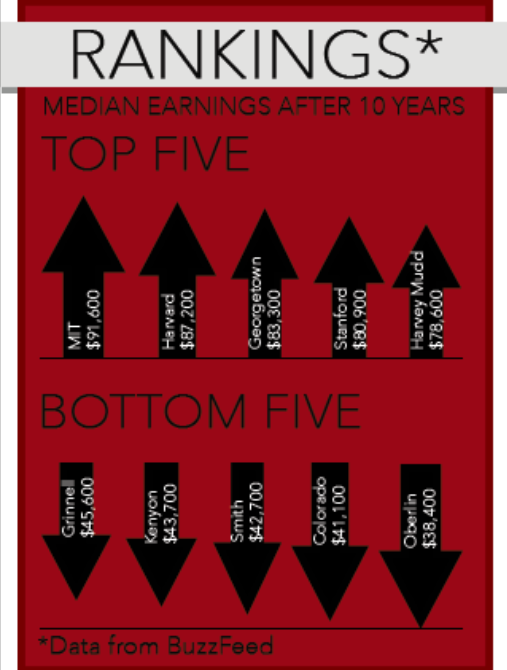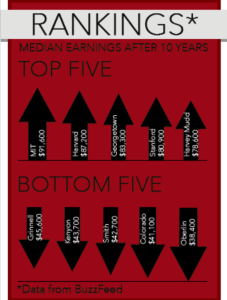ZANE SILK
silkniha@grinnell.edu
In the past few weeks, a number of rankings and ratings of the nation’s colleges have been released with varying results for Grinnell College. In the rankings of liberal arts colleges released by the U.S. News and World Report Grinnell (USNWR) held its place at number 19.
Days later, on Sept. 12, the Department of Education released their College Scorecard website, which allows families to compare colleges on a number of metrics. Three in particular are being highlighted: average annual cost after financial aid, median earnings ten years after students enrolled (excluding those who went to graduate school) and the six-year graduation rate of full-time students.
After the ranking’s release, Buzzfeed News ran an article comparing statistics from the College Scorecard for schools that ranked in USNWR’s Top 25 universities and liberal arts colleges. The only mention of Grinnell during the piece was the College’s ranking fifth lowest for median earnings, at $45,600, compared to top ranking the Massachusetts Institute of Technology’s $91,600.
On Sept. 16 the New York Times’ online data-driven portal, The Upshot, released its second annual College Access Index, measuring which colleges do the most for low-income students. Between the first and second year of the rankings, Grinnell College fell from second place to thirty first.
“The majority of change from two to our current [rank] is based strictly on methodological changes within the rating system itself,” said Brad Lindberg, director of Student Financial Aid.
“We really haven’t changed the way we’ve done things between when the survey was run last year and … this year,” he added.
The Upshot did change quite a few aspects of their formula. From originally only using the percentage of freshmen receiving Pell Grants in its calculations, The Upshot shifted to relying on the percentage of graduating students receiving the same grants. In addition, the data of students from households making $30,000 to $75,000 annually was used when calculating the net price for middle income students, an increase from the previous ceiling of $48,000.
Randy Stiles, associate vice president for Analytic Support and Institutional Research, explained that there were also other factors which contributed to the decline in Grinnell’s ranking.
“Moving from about 100 schools to 179 schools – there are now a lot of public [schools] that just weren’t there last year,” Stiles said.
The increase in schools was a result of The Upshot including colleges with graduation rates of 75 percent within five years, an increase from the previous limit of four years.
This led to the sudden success of the University of California, with UC colleges grabbing six of the top seven spots, when none had been on last year’s index.
On Tuesday, Sept. 22, Stiles gave a presentation detailing the different rankings and rating systems his office tracks. Despite the attention focused on the ratings within Stiles office, he claims that the College does not make reforms based on the reviews and rankings.
“We are not driven by rankings. We are not going to change what Grinnell does as a result of being somewhere on somebody’s ranking system,” Stiles said. “If we change a policy it’s not likely because we’re 12, or 14, or whatever on somebody’s list. It’s because we think it’s the right thing to do based on the college’s values.”
It was at the Times’ “Schools for Tomorrow” conference in New York City that David Leonhardt, managing editor for The Upshot, released the College Access Index. “Colleges that have historically been among the least diverse … [such as] Washington University in St. Louis, Yale, Middlebury, have begun taking steps to be more diverse. They’re early steps, they’re certainly not at the same level that … Grinnell [is] at, but they are steps in that direction,” Leonhardt said during his presentation.
Following the presentation, Leonhardt led a panel discussion featuring President Kington and the presidents of other colleges.
“We have a significant endowment; I think our budget for financial aid every year is … $46 million,” Kington said during the panel. “Right now I think we are at 24 percent Pell eligible, but we can’t get much higher than that and still work.”
“If you compare Grinnell to our peer group, while our endowment per student is relatively high, among our other two sources of income, [concerning] the rate of annual giving per student and the amount students pay in tuition, we are very low. The other schools, they have good returns, and donors are giving millions … We’d need a dramatic increase in alumni giving if we were going to increase the percent of students that are Pell eligible,” Kington wrote in an interview with The S&B.
Despite all the money that Grinnell pours into financial aid and academic resources, Kington explained that there is only so much small liberal arts schools like Grinnell can do to help assist low-income students.
“The fact is that the chance that a poor kid of color will go through an education system that prepares that person for one of our colleges is laughingly, just unbelievably small,” Kington said. The Upshot included colleges with graduation rates of 75 percent within five years, an increase from the previous limit of four years. This led to the sudden success of the University of California, with UC colleges grabbing six of the top seven spots, when none had been on last year’s index.































































patrick theut • Oct 29, 2015 at 3:37 pm
size matters – – – the smaller the better
Mike T • Oct 10, 2015 at 8:26 pm
I wish to add one example to illustrate why elite private liberal arts education is much more preferred to practical training at public university. My child is currently taking an Introduction to Biology(MCDV1a) at UCSB equivalent to Biology 150 at Grinnell College. My child is taking above class with 1200 other students. One auditorium is not big enough to house all 1200 students so UCSB placed them in two large auditoriums(one has a professor and one with live stream). Grinnell students, you are very lucky.
Mike T • Oct 10, 2015 at 7:31 pm
My child who has ACT of 30 applied to 10 elite private colleges for the fall of 2014 in hope of receiving financial aid as a low income student. Brandeis, Bucknell, Hamilton, Oberlin and Wesleyan denied. Bard, Colby. Franklin & Marshall, Grinnell(need blind) and Trinity College(CT) placed my child on waitlists that was subsequently declined to be on due to lack of financial aid for waitlisted applicants. However, University of California, Santa Barbara(UCSB) accepted my child and charged only $4,500 per year net tuition plus room and board cost. I believe that the enrollment management system software did not consider my child as favorably as a candidate for admission to elite private institutions who would have to come up with a large amount of financial aid to compete with UC system schools. I am somewhat glad that my child has UCSB as a back up and also able to to receive reasonable quality college education, although, my child much more preferred an elite private liberal arts education. It is clear that financial resources is a very important factor in deciding who receives an elite education in private institution and who obtains a practical training or pre-professional education in public university. For those students with enough family financial resources or very high academic achieving, elite private liberal arts education is a much better choice with a great value in long term. I congratulate all Grinnell students to receive a great education with relatively low net cost.